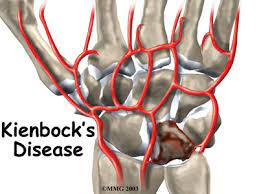Kienbock’s Disease
Welcome to our comprehensive guide on Kienbock’s Disease. If you’ve stumbled upon this article, you might be seeking answers about this condition. Kienbock’s Disease is a rare, but impactful, wrist condition that can have a significant impact on one’s quality of life. In this article, we aim to provide a clear understanding of Kienbock’s Disease, its causes, symptoms, and the available treatment options.
What Is Kienbock’s Disease?

Kienbock’s Disease, also known as avascular necrosis of the lunate, is a complex and relatively uncommon wrist condition that primarily affects a small bone in the wrist known as the lunate. To understand this condition better, let’s delve into its causes, symptoms, and the anatomy of the wrist.
the Anatomy of the Wrist
Before we dive deeper into Kienbock’s Disease, it’s crucial to grasp the fundamentals of wrist anatomy. The wrist is a complex joint composed of multiple bones, ligaments, and tendons that work together to facilitate movement and stability. Understanding this anatomy will help you comprehend how Kienbock’s Disease can impact this intricate structure.
Stages of Kienbock’s Disease
Kienbock’s Disease progresses through various stages, each with its own set of characteristics and implications. Understanding these stages is essential for both patients and healthcare professionals. In this section, we’ll walk you through the different stages of Kienbock’s Disease and what they entail.
Causes and Risk Factors
To gain a comprehensive understanding of Kienbock’s Disease, it’s vital to explore the potential causes and risk factors that may contribute to its development. This section will shed light on the factors that can increase the likelihood of developing Kienbock’s Disease.
Diagnosing Kienbock’s Disease
Diagnosing Kienbock’s Disease requires a combination of clinical evaluation, medical imaging, and sometimes, additional tests. This section will provide insights into how healthcare professionals diagnose the condition, helping patients understand what to expect during the diagnostic process.
Kienbock’s Disease Treatment Options
While Kienbock’s Disease can be challenging, there are various treatment options available to manage the condition and alleviate symptoms. This section will explore these treatment modalities, ranging from non-surgical interventions to surgical procedures, empowering individuals to make informed decisions about their healthcare.
Prevention and Outlook
While it’s not always possible to prevent Kienbock’s Disease, there are steps individuals can take to reduce the risk or slow down its progression. In this section, we’ll explore preventive measures and provide an outlook for individuals living with Kienbock’s Disease, offering hope and guidance for the future.
frequently asked questionsto Kienbock’s Disease:
1. What is Kienbock’s Disease?
Kienbock’s Disease, also known as avascular necrosis of the lunate, is a condition where the blood supply to the lunate bone in the wrist is disrupted, leading to its gradual deterioration.
2. What causes Kienbock’s Disease?
The exact cause of Kienbock’s Disease is not always clear, but it is often associated with factors like trauma, repetitive stress, or certain anatomical variations that affect blood flow to the lunate bone.
3. What are the common symptoms of Kienbock’s Disease?
Common symptoms include wrist pain, stiffness, limited range of motion, and swelling. As the condition progresses, these symptoms may worsen.
4. How is Kienbock’s Disease diagnosed?
Diagnosis typically involves a physical examination, imaging tests (such as X-rays and MRI), and sometimes a CT scan to assess the condition of the lunate bone and surrounding structures.
5. What are the stages of Kienbock’s Disease?
Kienbock’s Disease is classified into stages based on the severity of bone damage. Stages range from early, where changes are minimal, to advanced, where the bone may collapse.
6. Is Kienbock’s Disease treatable?
Yes, Kienbock’s Disease is treatable. The choice of treatment depends on the stage and severity of the condition and may include rest, medications, splinting, or surgery.
7. Can Kienbock’s Disease be prevented?
Prevention is challenging since the exact cause is not always known. However, avoiding wrist injuries and repetitive stress may help reduce the risk.
8. What are the surgical treatment options for Kienbock’s Disease?
Surgical options may include lunate reconstruction, bone grafting, or wrist fusion, depending on the stage and individual factors.
9. What is the prognosis for Kienbock’s Disease after treatment?
Prognosis varies depending on the stage at which treatment is initiated and the chosen treatment method. Early intervention generally leads to better outcomes.
10. Are there rehabilitation exercises for Kienbock’s Disease?
Yes, rehabilitation exercises can be part of the treatment plan to improve wrist strength and mobility after surgery or during conservative management. A physical therapist can provide guidance.
Conclusion
In this comprehensive guide to Kienbock’s Disease, we’ve explored its various aspects, from causes and symptoms to treatment options and coping strategies. Our aim is to empower individuals with knowledge, so they can make informed decisions about their healthcare. If you or a loved one is dealing with Kienbock’s Disease, remember that there is support and treatment available to enhance your quality of life.




